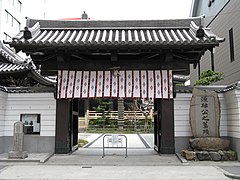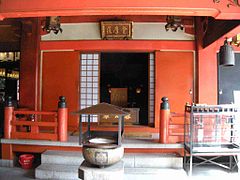Taiyu-ji
The Taiyū-ji ( Japanese 太 融 寺 ) is a temple of the Kōyasan branch ( 高 野山 派 ) of the Shingon direction of Buddhism in Osaka and attracts many pilgrims as the "main secondary temple " ( 準 別 格 本 山 Junbekkaku honzan ). It is the 2nd temple of the New Saigoku Pilgrimage .
history
The temple was founded by Priest Kukai in 821 at the request of Emperor Saga . He chose the thousand-armed Kannon ( 千手 観 音 菩薩 Senju Kannon ) as the main cult figure . Later on, Saga’s son Prince Minamoto no Tōru ( 源 融 ) expanded the complex with an area of 8 × 8 Chō (about 870 m²) to a "complete temple complex" ( 七 堂 伽藍 Shichidō garan ), which is known as "Naniwa no meisatsu" ( 浪 華 の 名刹 ) - "Great Temple of Old Osaka" - brought in.
In connection with the siege of Osaka Castle in 1615, the temple was destroyed. It was not until the Genroku period (1688–1704) that the temple with 25 buildings was restored, starting with the main hall and the large south gate. At the end of the Pacific War , the temple was lost again in 1945. In 1960 the main hall was rebuilt, followed by the rest of the temple complex.
investment
You can enter the temple through the west gate ( 西門 Saimon ; in plan 1) or through the simple south gate ( 南門 Nanmon ; 2). After the reconstruction, the temple includes the main hall ( 本 堂 Hondō ; 3) the bell tower ( 鐘楼 Shōrō ; 4), the small Hakuryū Ōkami shrine ( 白龍 大 神 ; 5), the pavilion for the temple founder, the Daishidō ( 大師 堂 ), the Fudō pavilion ( 不 動 堂 ), in which the holy Fudō ( 不 動 菩薩 ) is venerated, the Goma pavilion ( 護 摩 堂 ; 7), a treasure pagoda ( 宝塔 Hōtō ; 6), in which the holy Dainichi ( 大 日 如 来 ) is venerated, the area for pilgrims, the abbot and monk's quarters ( 本 坊 Honbō ; A) with dining room ( 庫裏 ). In the south extends the “nine mountains nine seas garden” ( 九 山 九 海 庭 Kuzan kukai niwa ; G).
At the west gate there is a memorial stone for Minamoto no Tōru, in the cemetery (F), there is the grave of the well-known concubine Hideyoshi Toyotomis , Yodo-dono ( 淀 殿 ), which adorns a six-step stone stupa ( 六 輪 塔 Rokurintō ). On a stele for Matsuo Bashō is his haiku "White chrysanthemum - shows itself conspicuously - but no deer".
photos
Remarks
- ↑ Originally the stone stupa had nine rings.
- ↑ The original haiku is: 「し ら 菊 の 目 に 立 て 見 る 鹿 も な し」 "Shira kiku no - me ni tatemiru - shika mo nashi." - Bashō refers to his follower Shibasoneme ( 斯波 園 女 ) from Old- Osaka, which he sings about as a white chrysanthemum because of its chastity.
literature
- Osaka-fu no rekishi sampo henshu iinkai (Ed.): Taiyū-ji . In: Osaka-fu no rekishi sampo (jo). Yamakawa Shuppan, 2007. ISBN 978-4-634-24627-0 . P. 37.
Web links
Coordinates: 34 ° 42 ′ 6.5 ″ N , 135 ° 30 ′ 14.7 ″ E







